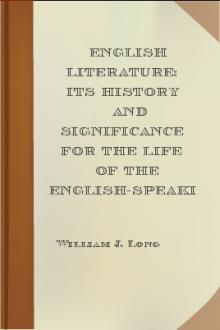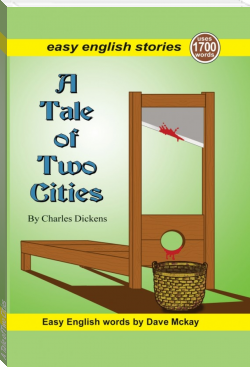English Literature: Its History and Significance for the Life of the English-Speaking World by William J. Long (good books for 8th graders txt) 📕

- Author: William J. Long
- Performer: -
Book online «English Literature: Its History and Significance for the Life of the English-Speaking World by William J. Long (good books for 8th graders txt) 📕». Author William J. Long
Dickens's Work in View of his Life. A glance through even this unsatisfactory biography gives us certain illuminating suggestions in regard to all of Dickens's work. First, as a child, poor and lonely, longing for love and for society, he laid the foundation for those heartrending pictures of children, which have moved so many readers to unaccustomed tears. Second, as clerk in a lawyer's office and in the courts, he gained his knowledge of an entirely different side of human life. Here he learned to understand both the enemies and the victims of society, between whom the harsh laws of that day frequently made no distinction. Third, as a reporter, and afterwards as manager of various newspapers, he learned the trick of racy writing, and of knowing to a nicety what would suit the popular taste. Fourth, as an actor, always an actor in spirit, he seized upon every dramatic possibility, every tense situation, every peculiarity of voice and gesture in the people whom he met, and reproduced these things in his novels, exaggerating them in the way that most pleased his audience.
When we turn from his outward training to his inner disposition we find two strongly marked elements. The first is his excessive imagination, which made good stories out of incidents that ordinarily pass unnoticed, and which described the commonest things--a street, a shop, a fog, a lamp-post, a stagecoach--with a wealth of detail and of romantic suggestion that makes many of his descriptions like lyric poems. The second element is his extreme sensibility, which finds relief only in laughter and tears. Like shadow and sunshine these follow one another closely throughout all his books.
Dickens and his PublicRemembering these two things, his training and disposition, we can easily foresee the kind of novel he must produce. He will be sentimental, especially over children and outcasts; he will excuse the individual in view of the faults of society; he will be dramatic or melodramatic; and his sensibility will keep him always close to the public, studying its tastes and playing with its smiles and tears. If pleasing the public be in itself an art, then Dickens is one of our greatest artists. And it is well to remember that in pleasing his public there was nothing of the hypocrite or demagogue in his make-up. He was essentially a part of the great drifting panoramic crowd that he loved. His sympathetic soul made all their joys and griefs his own. He fought against injustice; he championed the weak against the strong; he gave courage to the faint, and hope to the weary in heart; and in the love which the public gave him in return he found his best reward. Here is the secret of Dickens's unprecedented popular success, and we may note here a very significant parallel with Shakespeare. The great different in the genius and work of the two men does not change the fact that each won success largely because he studied and pleased his public.
General Plan of Dickens's Novels. An interesting suggestion comes to us from a study of the conditions which led to Dickens's first three novels. Pickwick was written, at the suggestion of an editor, for serial publication. Each chapter was to be accompanied by a cartoon by Seymor (a comic artist of the day), and the object was to amuse the public, and, incidentally, to sell the paper. The result was a series of characters and scenes and incidents which for vigor and boundless fun have never been equaled in our language. Thereafter, no matter what he wrote, Dickins was lbeled a humorist. Like a certain American writer of our own generation, everything he said, whether for a feast or a funeral, was spposed to contain a laugh. In a word, he was the victim of his own book. Dickens was keen enough to understand his danger, and his next novel, Oliver Twist, had the serious purpose of mitigating the evils under which the poor were suffering. Its hero was a poor child, the unfortunate victim of society; and, in order to draw attention to the real need, Dickens exaggerated the woeful condition of the poor, and filled his pages with sentiment which easily slipped over into sentimentality. This also was a popular success, and in his third novel, Nicholas Nickleby, and indeed in most of his remaining works, Dickens combined the principles of his first two books, giving us mirth on the one hand, injustice and suffering on the other; mingling humor and pathos, tears and laughter, as we find them in life itself. And in order to increase the lights and shadows in his scenes, and to give greater dramatic effect to his narrative, he introduced odious and lothsome characters, and made vice more hateful by contrasting it with innocence and virtue.
His charactersWe find, therefore, in most of Dickens's novels three or four widely different types of character: first, the innocent little child, like Oliver, Joe, Paul, Tiny Tim, and Little Nell, appealing powerfully to the child love in every human heart; scond, the horrible or grotesque foil, like Sqeers, Fagin, Quilp, Uriah Heep, and Bill Sykes; third, the grandiloquent or broadly humorous fellow, the fun maker, like Micawber and Sam Weller; and fourth, a tenderly or powerfully drawn figure, like Lady Deadlock of Bleak House, and Sydney Carton of A Tale of Two Cities, which rise to the dignity of true characters. We note also that most of Dickens's novels belong decidely to the class of purpose or problem novels. Thus Bleak House attacks "the law's delays"; Little Dorrit, the injustice which persecutes poor debtors; Nicholas Nickleby, the abuses of charity schools and brutal schoolmasters; and Oliver Twist, the unnecessary degradation and suffering of the poor in English workhouses. Dickens's serious purpose was to make the novel the instrument of morality and justice, and whatver we may think of the exaggeration of his characters, it is certain that his stories did more to correct the general selfishness and injustice of society toward the poor than all the works of other literary men of his age combined.
The Limitations of Dickens. Any severe criticism of Dickens as a novelist must seem, at first glance, unkind an unnecessary. In almost every house he is a welcome guest, a personal friend who has beguiled many an hour with his stories, and who has furnished us much good laughter and a few good tears. Moreover, he has always a cheery message. He emphasizes the fact that this is an excellant world; that some errors have crept into it, due largely to thoughtlessness, but that they can be easily remedied by a little human sympathy. That is a most welcome creed to an age overburdened with social problems; and to criticise our cheery companion seems as discourteous as to speak unkindly of a guest who has just left our home. But we must consider Dickens not merely as a friend, but as a novelist, and apply to his work the same standards of art which we apply to other writers; and when we do this we are sometimes a little disappointed. We must confess that his novels, while they contain many realistic details, seldom give the impression of reality. His characters, though we laugh or weep or shudder at them, are sometimes only caricatures, each one an exaggeration of some peculiarity, which suggest Ben Jonson's Every Man in His Humour. It is Dickens's art to give his heroes sufficient reality to make them suggest certain types of men and women whom we know; but in reading him we find ourselves often in the mental state of a man who is watching through a microscope the swarming life of a water drop. Here are lively, bustling, extraordinary creatures, some beautiful, some grotesque, but all far apart from the life that we know in daily experience. It is certainly not the reality of these characters, but rather the genius of the author in managing them, which interests us and holds our attention. Notwithstanding this criticism, which we would gladly have omitted, Dickens is excellent reading, and his novels will continue to be popular just so long as men enjoy a wholesome and absorbing story.
What to Read. Aside from the reforms in schools and prisons and workhouses which Dickens accomplished, he has laid us all, rich and poor alike, under a debt of gratitude. After the year 1843 the one literary work which he never neglected was to furnish a Christmas story for his readers; and it is due in some measure to the help of these stories, brimming over with good cheer, that Christmas has become in all English-speaking countries a season of gladness, of gift giving at home, and of remembering those less fortunate than ourselves, who are still members of a common brotherhood. If we read nothing else of Dickens, once a year, at Christmas time, we should remember him and renew our youth by reading one of his holiday stories,--The Cricket on the Hearth, The Chimes, and above all the unrivaled Christmas Carol. The latter especially will be read and loved as long as men are moved by the spirit of Christmas.
Tale of Two CitiesOf the novels, David Copperfield is regarded by many as Dickens's masterpiece. It is well to begin with this novel, not simply for the unusual interest of the story, but also for the glimpse it gives us of the author's own boyhood and family. For pure fun and hilarity Pickwick will always be a favorite; but for artistic finish, and for the portrayal of one great character, Sydney Carton, nothing else that Dickens wrote is comparable to A Tale of Two Cities. Here is an absorbing story, with a carefully constructed plot, and the action moves swiftly to its thrilling, inevitable conclusion. Usually Dickens introduces several pathetic or grotesque or laughable characters besides the main actors, and records various unnecessary dramatic episodes for their own sake; but in A Tale of Two Cities everything has its place in the development of the main story. There are, as usual, many characters,--Sydney Carton, the outcast, who lays down his life for the happiness of one whom he loves; Charles Darnay, an exiled young French noble; Dr. Manette, who has been "recalled to life" from a frightful imprisonment, and his gentle daughter Lucie, the heroine; Jarvis Lorry, a lovable, old-fashioned clerk in the big banking house; the terrible Madame Defarge, knitting calmly at the door of her wine shop and recording, with the ferocity of a tiger licking its chops, the names of all those who are marked for vengeance; and a dozen others, each well drawn, who play minor parts in the tragedy. The scene is laid in London and Paris, at the time of the French Revolution; and, though careless of historical details, Dickens reproduces the spirit of the Reign of Terror so well that A Tale of Two Cities is an excellent supplement to the history of the period. It is written in Dickens's usual picturesque style, and reveals his usual imaginative outlook on life and his fondness for fine sentiments and dramatic episodes. Indeed, all his qualities are here shown, not brilliantly or garishly, as in other novels, but subdued and softened, like a shaded light, for artistic effect.
Those who are interested in Dickens's growth and methods





Comments (0)